Who Needs God, We Have Bankers October 30, 2013
Doug Wakefield
The snooze
button; what a great invention. When you
have awakened from a deep sleep, and know you can get ready in less time, just
hit the snooze button. You know it will still awaken you for your test or to
get ready for your 8:00 flight, but in the meantime, you can enjoy a few more
moments of precious sleep.
However, if you
keep hitting snooze and fail to look at the time, you can also awaken to find
that the extra sleep has now placed you in a position where you missed the
final exam or your flight. The rewards for a few extra moments of sleep have suddenly
become very costly.
Since the largest
collapse of financial assets in history in 2008, the major central banks in the
world, the Bank of Japan, The
People’s Bank of China, the European Central Bank,
the Federal Reserve, and the
oldest of this group, the Bank of
England, have worked together to create the largest asset bubbles ever seen
while keeping the public in a perpetual state of blissful sleep. The method is
actually quite simple.
Offer ultra cheap
credit to the global banks by which they can go promote even wilder
speculation. Allow extreme levels of leverage in the system, something the
general investor seems to never be aware of along the way. If things start looking weak, make certain
the standards for collateral against those loans for speculation are LOWERED,
allowing even more reckless behavior into the system. Finally, allow the world
to watch as Russia
and China
send their navies toward Syria at the same time the United States announces
they are preparing for a military strike on Syria over chemical weapons, and a
month later, have the United States shut down its government for the first time
in 17 years while warning of a catastrophe that should it default on its debt
by October 17th…. only to see by the end of October these scary
headlines drift into the background noise as stocks sail once again to all time
highs.
One can see why
consciously or unconsciously, global bankers have become our gods. As has been
repeatedly stated before, we should remove the term “In God We Trust”, and
replace it with “In Debt We Trust”, since this would be a more accurate
reflection of our global view of money.
Yet, like the
alarm clock, we know that the alarm is going off. It is time to get up and stay
awake. It is not time to hit the snooze button toward risk.
“Without
market discipline,” said Nouriel
Roubini, chairman of Roubini Global Economics LLC, “there’s no
pressure to do anything because you can continue to finance yourself cheaply.”
[Is
U.S. Political Bubble About to Burst?, Bloomberg, Oct 10 ‘13]
Snooze Buttons
At this stage,
you are probably saying, “Now Doug, that is a bit over the top.” Yes, but so is
the FACT that today the US
national debt stands at $17,000 billion ($17 trillion), while on December
23, 1913 when the Federal Reserve Act was passed establishing a private
corporation of global bankers to control the US monetary system, the total U.S.
national debt stood at $3 billion. This is not a dream, just cold hard
reality.
So as any good
detective would tell us, let’s look at the evidence, to determine where we ALL
are, as we come to the end of October 2013.
Question – Did cheap credit contribute to the 2007 bubble,
which was the “recovery” from the tech bubble, and is there evidence that ultra
cheap credit is still at the foundation of the now 5-YEAR recovery?
Answer – Look at a chart of the yield on 90-day Treasury
bills. If the world is willing to park cash in 90 day increments to the US.
Government at these rates, do we now understand why earning
any money on cash equivalents like CDs has been so low since 2008?
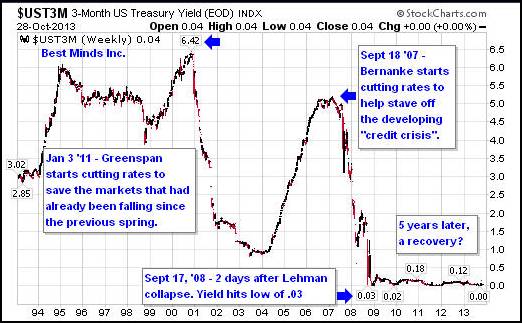
We should also be
asking the question, “After five years where U.S. stocks have produced the
equivalent of the tech rally in the late ‘90s, why is there so much money still
sitting in cash at rates that are virtually zero? Is there still fear of
another repeat of 2008 or worse?”
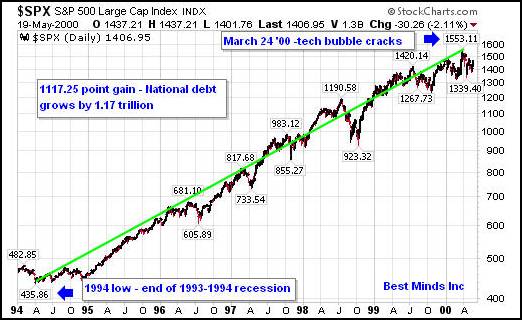
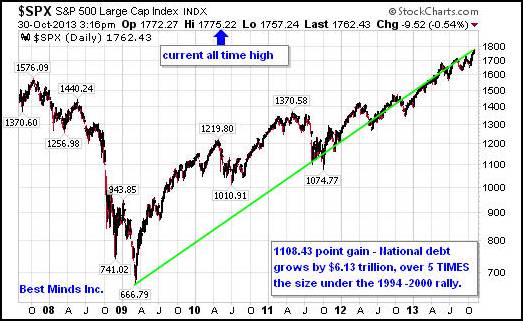
Question – Have extreme amounts of leverage been the
iceberg underneath this entire rally?”
Answer – Yes. Once again, the evidence is there for those
interested.
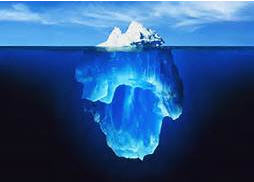 After the largest losses of capital in history in 2008, it was time to
regroup, and rebuild. Neil Barofsky, the Special Inspector General appointed by
Congress as the watchdog over the Treasury Asset Relief Program [TARP], had a
better view of the foundations of “the recovery” than almost anyone in the
world. This is what he watched take place to kick start the “recovery” five
years ago:
After the largest losses of capital in history in 2008, it was time to
regroup, and rebuild. Neil Barofsky, the Special Inspector General appointed by
Congress as the watchdog over the Treasury Asset Relief Program [TARP], had a
better view of the foundations of “the recovery” than almost anyone in the
world. This is what he watched take place to kick start the “recovery” five
years ago:
“The heart of Geithner’s proposal, however, was in
the second part, the ‘legacy securities’ program, which was the realization of
Lee Sach’s goal back in January (2009) to ‘go big’ on the toxic assets still
clogging the bank’s arteries. The program was to be run by Treasury in tandem
with TALF [Term Asset Backed Securities Loan Facility], which was run by the
Fed. It would start with a handful of preselected private fund managers, who
would raise a sum of private funds. Treasury would then match the private
amount raised, dollar for dollar, and then lend additional TARP [Troubled Asset
Relief Program] money through nonrecourse loans to the funds, each of which
would be called a Public-Private Investment Fund.” [Bailout:
An Insider’s Account of How Washington Abandoned Main Street While Rescuing
Wall Street (June 2012) Neil Barofsky, pg 130 of 270 in Kindle Edition]
Doesn’t
this sound like China’s “State Capitalist” System? Barofsky continues:
“Depending on the amount of the loan, Treasury would
put in either two-thirds or three-quarters of the money into the fund but again
would have rights to only half of its profits. Once fully funded with taxpayer
and private money, the private fund manager would be able to use the combined
funds as the ‘haircut’ to acquire a far larger nonrecourse loan from the
Federal Reserve, via TALF, to buy legacy mortgage-backed securities. In other
words, the private fund manager could use one TARP program that was massively
leveraged with taxpayer funds and then leverage it again through another TARP
program that itself was massively leveraged with taxpayer money. That ‘leverage
on leverage’ gave Wall Street a huge potential upside for profits while leaving
the taxpayer on the hook for massive potential losses.”[Ibid]
Author
and journalist, Scott Patterson, reminds us that today’s dominate predator, the
high speed trading machines, continue to foster massive leverage underneath the
markets that both big and small investors are depending on every day.
“Many of
the high-speed firms deployed massive amounts of leverage, or borrowed money,
as much as fifty to one by the late 2000s (for every dollar they owned, they
borrowed another fifty dollars from banks and brokers in the hope of amplifying
their profits). As the financial meltdown of 2008 showed, massive leverage can
quickly unravel and trigger devastating, out-of-control meltdowns.” [Dark
Pools: The Rise of the Machine Traders and the Rigging of the U.S. Stock Market
(June 2013) Scott Patterson, pg 40 of 336 on Kindle Edition]
Even
Alan Greenspan, who did not know what a bubble looked like in April 2000, has
finally awakened to understand them in October 2013.
“…on April 13, 2000 [March 24th being
the all time high that the NASDAQ still holds 13 year later], when the Chairman
was in front of the Senate Banking Committee, he was asked if an interest rate
hike would prick the stock market bubble. He responded: ‘That presupposes I know
that there is a bubble….I don’t think we can know there’s been a bubble until
after the fact. To assume we know it currently presupposes that we have the
capacity to forecast an imminent decline in prices.’” [Greenspan’s
Bubbles: The Age of Ignorance at the Federal Reserve (2008) William
Fleckenstein with Frederick Sheehan, pgs 98-99]
Bubbles
and Leverage Cause Crises: Alan Greenspan, CNBC, Oct 23 ‘13
“‘Asset
bubbles alone don't cause financial crises like the one in 2008’, former
Federal Reserve Chairman Alan Greenspan told CNBC on Wednesday. ‘Instead, the
combination of bubbles and leverage is the problem’, he said.
‘We
missed the timing badly on September the 15th, 2008 [the day Lehman Brothers
filed for bankruptcy]. All of us knew there was a bubble. But a bubble in and
of itself doesn't give you a crisis,’ he said in a ‘ Squawk Box’ interview.
‘It's turning out to be bubbles with leverage.’”
So are we clear?
The “recovery” was kicked started on the same massive leverage that Greenspan
discussed last week! After watching what “bubbles with leverage” did to markets
from “timing badly” the bursting of the global illusion in September 2008,
certainly five years is long enough for global banks and central bankers to
have done something about this problem.
Question – If cheap credit, and the ability to ramp up
returns with more leverage has been at the root of the global banking system
since 2008, are there other warning signs at the INDUSTRY level, that there is
deep concern about risk from herding both big and small players in the same
direction for long periods of time with the promise of “we will not stop
printing until the economy is in full recovery mode”?
Answer – Don’t hit the snooze button. Get a strong coffee
and keep reading.
BIS
Veteran Says Global Credit Excess Worse Then Pre-Lehman, The Telegraph,
Sept 15 ‘13
The
Swiss-based `bank of central banks’ said a hunt for yield was luring
investors en masse into high-risk instruments, “a phenomenon reminiscent of
exuberance prior to the global financial crisis”.
This is happening just as the US Federal Reserve prepares to wind down stimulus and starts to drain dollar liquidity from global markets, an inflexion point that is fraught with danger and could go badly wrong.
“This looks like to me like 2007 all over again,
but even worse,” said William White, the BIS’s former chief economist, famous
for flagging the wild behaviour in the debt markets before the global
storm hit in 2008.
“The
challenge is to be prepared. This means being prudent, limiting
leverage, and avoiding the temptation of believing that the market will remain
liquid under stress, the illusion of liquidity,” he [Claudia Borio,
the BIS research chief] said.
The
BIS enjoys great authority. It was the only major global body that clearly
foresaw the global banking crisis, calling early for a change of policy at a
time when others were being swept along by the euphoria of the era.
[Italics my own, quote also in Oct 2nd article]
US
Treasury Says Money Managers May Pose ‘Herding’ Threat, Bloomberg, Sept 30
‘13
The
Treasury Department said money managers could pose threats to the U.S.
financial system when reaching for higher returns, herding into popular asset
classes or amplifying price movements with leverage.
Companies
overseeing a combined $53 trillion in assets, led by fund giants BlackRock
Inc. (BLK) and Vanguard Group Inc., can contribute to asset price
increases and magnify volatility during sudden shocks, a report by the Treasury
said today. Gaps in data, particularly on investments managed for institutions,
limited the study’s ability to identify additional risk.
“A
certain combination of fund- and firm-level activities within a large, complex
firm, or engagement by a significant number of asset managers in riskier
activities, could pose, amplify or transmit a threat to the financial system,”
the Treasury’s Office of Financial Research said in the report.
The
study was conducted by the OFR to help the Financial
Stability Oversight Council analyze whether asset managers should be
considered systemically important and subject to Federal Reserve supervision.
[Italics mine]
“Quantitative
easing (‘QE’) and uncertainty around tapering of asset purchases by the Federal
Reserve and other central banks is limiting the ability of insurance
companies to generate returns, and driving them to diversify towards riskier
assets, according to new research into the investment strategies of over
200 insurers globally….
Unveiled in a report called Global Insurance: Investment strategy at an Inflection Point?, produced by BlackRock, Inc. (NYSE:BLK) in partnership with The Economist Intelligence Unit (‘EIU’), the results highlight insurers’ changing investment attitudes in response to central bank policy. With last Wednesday’s [Sept 18th Fed press release] decision to continue QE at its current pace, the report suggests insurers need to consider how this uncertainty affects their overall strategic asset allocation and the potential impact on their businesses….
Low yields on investments were identified as the most critical driver of change affecting the industry with 73 per cent of respondents citing this. 80 per cent agreed their business will have to change to produce adequate shareholder returns over the next three years….
In a ‘QE-infinity’ world before potential tapering was discussed by the Fed, insurers said they were highly likely to increase allocations to riskier, higher yielding fixed income instruments such as bank loans and lower rated debt (73 per cent), and illiquid strategies (68 per cent). In an environment where QE tapering was expected, however, insurers changed their investment approaches and risk appetite.
Help me out here. Has the financial world gone mad? How
did we come to a point, where an entire industry has poured money into RISKIER
assets, and is waiting for words from one tiny group of people in the world to
say, “We will slow down the Ponzi scheme” as their predominate signal to start
SELLING the “lower rated debt and illiquid strategies”? How many millions of investors
are piling into fixed rate products thinking that big companies handling their
own funds are being “conservative” with the money backing those “conservative”
investments? Never has it been more important to know who is following the
herd, and who are independent players in this global “all in” card game.
Ok, let’s ask two more questions.
Question – Have global banks and their central
banking private clubs LOWERED the standard on the type of collateral they will
accept as markets risk have INCREASED?
Answer – One only needs to read publicly available information to see that they have done just that. In fact, lowering standards was how we kick started the “recovery”.
Mortgage-Backed Securities Index Surges on Toxic-Asset Plan, MarketWatch, March 23, 2009
An
index that tracks the perceived value of subprime
mortgage-backed securities on Monday jumped 1.09 to 25.29, the biggest one-day
gain since Feb. 9, said Markit, which publishes the index. Markit's ABX.HE.AAA,
series 7-2, which reflects some of the most recent securitized pools of the the
best-quality subprime mortgages, rallied after the Treasury Department
released details of a plan to encourage investors
to buy banks'
illiquid assets, including these types of mortgage-backed securities.
[italics mine. Reread Barofsky’s comments shown earlier]
The H.4.1 report
reveals the publicly available balance sheet of the most powerful
central bank in the world outside the Bank of International Settlements in
Switzerland, the Federal Reserve, as of October 24, 2013. How will the Federal
Reserve, the largest holder of mortgage backed securities – an asset the banks
had to sell to the Feds in order to “unfreeze” the credit markets in the spring
of 2009, get rid of the $1.3 trillion worth of mortgage backed securities they
hold on their balance sheet today…while they continue purchasing them today? I
know, kick the can down the road some more.
Hit the snooze button.
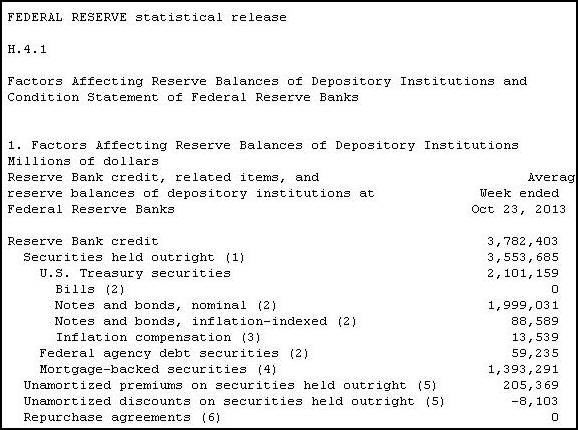
Today, we have the
ability to translate articles written in other languages different from our
own. The following article is a translation of an article that appeared in the
German Economic News this summer. It reveals the decision by European and
Chinese central bank leaders to LOWER the requirements for collateral by which
financial institutions could borrow more money to speculate, thus following the
herd to even more unsustainable behavior….
Central
Banks Bring Weapons of Mass Destruction in Position, German Economic News,
July 17, 2013
In
a concerted action, the ECB and China have decided to allow dangerous risk
securities as collateral for loans. So that banks are allowed to open a new casino
table. It is the same where the bomb went off in 2007 that triggered the
financial crisis.
On
Thursday, the Chinese and the ECB decided that the mood in the global
financial casino must be improved. For this purpose, inferior securities
are admitted as collateral for new loans. In the ECB Southern Europeans
- apparently against the wishes of Bundesbank chief Jens Weidmann - enforced
that future risk securities with lower credit ratings may be pledged as
collateral for loans. These are so-called asset-backed securities (ABS).
These are debt securities backed by real assets are: the company's shares,
cars, real estate. Until now, such papers have a Triple A credit rating as, now
have an A., regulators lifted a restriction on such dangerous enough papers in China.
Large banks can now pump a lot more of the toxic assets in the system….
…
the central banks were key sponsors of the documents specified by
Warren Buffet as "weapons of mass destruction." The then head
of the U.S. Federal Reserve and Grand Master of the low interest rate policy,
Alan Greenspan praised the products that should eventually lead to the crash,
as especially valuable because they "spread the risk". And the German
Bundesbank had the presumption to the forecast, that of all the ABS strengthen
the resilience of the financial system would alleviate shocks.
The
bomb exploded as the rating agency
Moody's on 15 June 2007, the rating was reduced from 131 ABS and the papers
downgraded. Standard & Poor's followed in July - the crash was initiated, which
eventually culminated with the collapse of Lehman.
Apparently,
the central banks have learned nothing from history. …
The calculation is: It takes as many individual
papers as possible, to minimize the probability of failure.
The reality: If one assumption is wrong, crashing
the global financial system together. This could be the case for example with the
ABS on cars. The lobby TSI priced cars to be
particularly suitable, because they - in theory - always have a value. However, as the time of the entire U.S. housing market
collapsed in the wake of the crisis of the entire European automotive market, then
the system collapses.
The banks know that too exactly, but are hoping
that the game can drag on for a while. And to those of today meantime it is up to
the crash: This will allow the ABS made billions and bonuses satteste be bagged
easily.
It's about the unrestrained greed of an industry
that makes money at the expense of the public with purely artificial products and without a hint of morality.
[Bold text in original article]
The great libertarian
publication, The Daily Bell, based
out of Canada, reveals that this week, the Bank of England, the second oldest
central bank (1694) in the world after Swedish central bank (1668), has LOWERED
its standards on collateral for fresh new loans, following the same pattern
from Europe and China in July.
Carney
Gets Ready to Blow Up The World, The Daily Bell, Oct 29 ‘13
Today, a new regime has arrived. Central banks need
to "keep up" with financial market developments, Mr Carney said at a
Financial Times event. The BoE is rolling up its sleeves and doing what is
necessary to keep the banking sector humming – in both the normal course of
business and in crisis conditions….
The terms on which the BoE will engage with the private banking sector will be significantly eased under the new governor's framework. Banks will be able to borrow against a broader range of collateral, including portfolios of loans, for longer periods of time and in exchange for fees that in some cases will be halved. "Banks can be confident that, when they want to use our facilities, they will be allowed to access them," the governor said….
Accordingly the BoE's discount window facility,
which banks can approach confidentially when they are facing temporary cash
crunches, will have a lower, flat-rate "entry fee". The BoE will
delay the disclosure of any use of the facility as it seeks to minimise the
risks of banks being punished in the markets for accessing it. The BoE's
indexed long-term repo auction, a standard monthly facility, will also be
cheaper and will be offered against a broader range of collateral and for an
extended term.
So
do we expect central bankers to warn us before a market breakdown from all
their reckless actions? Look back at Greenspan’s testimony just days after the
tech bubble had already burst in 2000? Do we not remember that Hank Paulson told us of
the healthy economy in April 2007, and that “the worst was behind us” in May
2008? If we are counting on these
political/financial leaders to give us “a signal”, we are indeed fools.
Question – Surely a major military confrontation between
Russia and the US over Syria could slow up the global computer lead euphoria?
If not, a shutdown for the first time in 17 years of the US government, as well
as a lack of funds to run the nation by October 17th would certainly bring
about fear, and kick start the selling of the riskiest assets in our global
financial system?
Answer – Nope. It would seem that even the possibility of
a major war in the Middle East and the shutdown of the US government are now to
be viewed as no big deal by all investors. Now, the only thing that seems to
matter, is for the global central banks to keep pouring cheap loans into the
system, continue LOWERING their standards on collateral, - the same behavior
that lead to the start of the credit crisis in August 2007 - and continue
promoting the herding of entire markets and industries globally into riskier
assets.
When Should I Sell?
From
my excellent contacts at the 5 most powerful central banks in the world, and
the granddaddy of them all, the Bank of International Settlements, I must tell
you they are still working on it. Actually, I have not been able to get a
return on any of my calls lately. It would seem they realize that the extremes
in complacency today will turn to extreme anger when the claws of the next
market crash rip through the finances of businesses and individuals worldwide,
and had rather feed the nirvana mania until the dominoes start to fall.
However,
it would appear that the control of crowds of angry people have already been
given some thought by the boys at mission control. Since I am sure you can find
a plethora of information on this topic, let me stick purely to one of the
biggest warnings signals for businesses and individuals today in the financial
world.
First Were Bail Outs, Next Are Bail Ins – Someone is planning for the next Lehman Event, Are You?
Step
One – If you are in the financial industry, or in a position of leadership in a
business, church, or organization where people depend on your knowledge of the
world of finance, you must download and read the document, Resolving Globally Active,
Systemically Important Financial Institutions: A Joint Paper by the FDIC and
the Bank of England, released on December 10, 2012. A copy of the paper
along with other articles about the topic were posted on the Research page of the Best
Minds Inc website in September, and can be accessed for free.
Step
Two- Watch the film, Money
Is Not Safe In The Big Banks, by the Public Banking Institute (posted on
youtube on Aug 28 ’13). As much time as we waste these days trying to keep up
with our busy schedules, this film will take you less than 15 minutes to watch,
and I can assure you, will be an eye opener and more important than 99% of “the
busy” things that consume our day.
Step
Three – Remember, just because we live in a nation larger than Cyprus, don’t
think with the global level of problems revealed in this article, that our
story will turn out different simply because
“this will never happen in our country”.
“I
Went to Sleep a Rich Man. I Woke A Poor Man”, The Sydney Morning National Herald,
March 29, 2013
“‘Very
bad, very, very bad,’ says 65-year-old John Demetriou, rubbing tears from his
lined face with thick fingers. ‘I lost all my money.’
John
now lives in the picturesque fishing village of Liopetri on Cyprus' south
coast. But for 35 years he lived at Bondi Junction and worked days, nights and
weekends in Sydney markets selling jewellery and imitation jewellery.
He
had left Cyprus in the early 1970s at the height of its war with Turkey, taking
his wife and young children to safety in Australia. He built a life from
nothing and, gradually, a substantial nest egg. He retired to Cyprus in 2007
with about $1 million, his life savings.
He
planned to spend it on his grandchildren - some of whom live in Cyprus -
putting them through university and setting them up. There would be medical
bills; he has a heart condition. The interest was paying for a comfortable
retirement, and trips back to Australia. He also toyed with the idea of buying
a boat.
He
wanted to leave any big purchases a few years, to be sure this was where he
would spend his retirement. There was no hurry. But now it is all gone.
‘If
I made the decision to stay, I was going to build a house,’ John says.
‘Unfortunately I didn't make the decision yet’.
‘I
went to sleep Friday as a rich man. I woke up a poor man.’
While John did end up
with money, it was certainly not anything close to what he had saved all his
life. Remember, he was not speculating on higher stock and junk bond prices.
His money was sitting in one of the biggest banks in his country.
“George
says he can start again - if things get worse he and his family might move back
to Australia.
‘But
not my dad. He can't go back to Australia. He is not allowed to fly because of
his heart, and anyway where would he live? He has no house. He will have
€100,000 left to live off. Soon he's not going to have a cent to his name.’
John
has a thin hope. His money was sitting in the bank in Australian dollars
instead of euros, so he wonders if it would be exempt from the bank's collapse.
But the bank's doors are closed, so he doesn't even know to whom he should put
that argument.”
Step Four: Understand that like the chart of the
commercial hedgers revealed in my last public article, The
Easy Money Addiction Exit Plan, there are very powerful players in the
world of money who are set for a powerful drop, and will profit from the
decline. They know where the next trend is headed, and there actions prove it.
The ones that will lose the most in the bursting of the current global bubble,
will be those gullible enough to sit tight and wait for the next blowout debt
bubble to levitate their brokerage statements again.
Since the last major
bottom in 2009 brought with it the expansion of the only international
electronic currency in the world, the Special
Drawing Rights, I believe when we arrive (2014 or 2015) at the next major
bottom in history we will even see a challenge from the China
renminbi over the US dollar inside the global currency, the Special Drawing
Rights. Sounds wild, but I did not find many who thought the Special Drawing
rights would expand rapidly before 2009 either, and yet, like any idea outside
the crowd, there is plenty of information supporting these theories ahead of
time if you looking for change, and do NOT expect things to stay the same. [If
you are unfamiliar with world developments surrounding this global electronic
currency in 2009, read my public article, Power Shift,
Oct 28, 2009]
To Those of You, Who Like Me, Enjoy Your Sleep
In the last two years, the
theme in stocks has been “no pain, all gain, central planners and debt are your
friends”. The true contrarians in the market, shorting overpriced stocks, have
been placed on the endangered species list. Managers who have sat with high
levels of cash for months have lost clients seeking to chase past performance.
Only an “all in, we follow the herd” mentality, fostered by the central bankers
themselves, has paid off. Independent thinking has been crushed. Following
blindly the institution that gave no sell signals to the public at the top of
the two previous bubbles are today worshipped as the one institution that this
time, will be different. This time, they will tell us when it is time to
“taper” our addiction to “get in now”.
It is my belief, that the greatest challenge to the period of time in front of us are our deeply ingrained beliefs, that can easily be proven are false. We don’t want to change, and we especially don’t want to think that we are depending on ideas that cannot possibly be true, such as borrowing our way to success.
We have come to believe that the image of wealth is the same as true wealth; that our material wealth is superior to our human relationships. We are divided along lines of rich and poor, blacks and whites, Americans and Chinese, old and young, etc, etc. Our labeling of others, perfectly normal when we are afraid or our ideas being challenged, has kept us from seeing a much larger evil around us. An evil that is rewarding deception and corruption, and pushing power into fewer hands, while setting up the lives of millions to only seek the next solution presented to them by a small number of individuals at the highest levels of global finance and politics. This is not a conspiracy, it is out in the open for anyone who reads and thinks. This is life and it is our world in 2013!
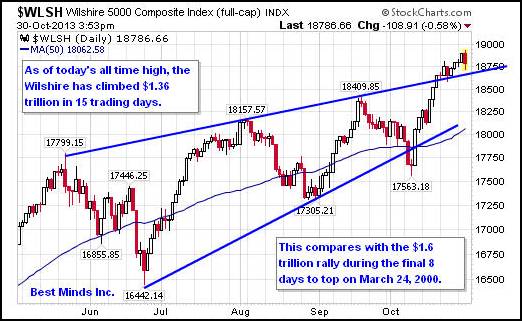
We are following a big lie, that more debt, and less control over our futures is a good thing. Since we are busy, we go back to sleep, hit the snooze button, and wait for someone to wake us when it is time for the next thing on the schedule.
Are we not being manipulated as crowds
rather than thinking as independent individuals who still today live in free
societies? Are we so afraid of standing outside the crowd that we fear more
rejection from friends and family than kindly standing outside the crowd and
encouraging others to use their own minds?
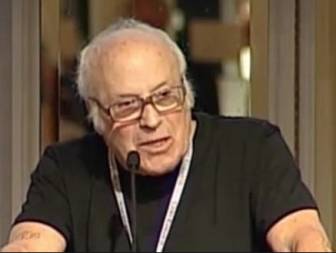 In the last ten years I have found the comments of
investment newsletter legend Richard Russell, read by many, to be grounded in a
thorough knowledge of the fact that a debt based currency in the hands of a
small number of central bankers is NOT moving us toward more opportunities and
a stronger environment for freedom to flourish.
In the last ten years I have found the comments of
investment newsletter legend Richard Russell, read by many, to be grounded in a
thorough knowledge of the fact that a debt based currency in the hands of a
small number of central bankers is NOT moving us toward more opportunities and
a stronger environment for freedom to flourish.
In the last 50 years, I have found the
comments of philosopher and thinker, Francis Schaeffer (1912-1984) to be widely
influential on church leaders in the West. Consider Russell’s recent comments
and Schaeffer’s. Are these similar themes, one man writing in 2013 and the
other writing in 1970?
“…I believe that the law of
supply and demand is a natural law, and it's a moral law given to the planet by
God. The whole concept of creating money without toil or risk is an
integral province of the Federal Reserve. I believe that one way or
another the Federal Reserve and all it stands for will be eliminated. The
process by which this will occur worries me. I believe it will take a huge
disruption of our current economic system in order to eliminate the Federal
Reserve and its immoral process of money being created out of a computer and
thin air.
The process of creating
money from “nothing” makes a mockery of real work of all kinds. Thus, by
inference, I am calling the Federal Reserve an evil institution.” [Richard
Russell, writer of the Dow
Theory Letters, the oldest continuous investment newsletter in the world
today (started in 1958). These comments were found in an interview
 with King World News on Aug 13 ’13]
with King World News on Aug 13 ’13]
“It is obvious: the future
is open to manipulation. Who will do the manipulating? Will it be the new elite
on the side of an establishment authoritarianism or another elite? Whoever
achieves political or cultural (and I would add financial) power in the
future will have at his disposal techniques of manipulation that no
totalitarian ruler in the past ever had. None of these are only future; they
all exist today waiting to be used by the manipulators…
We are surrounded on every
side with the loss of truth, with the possibility of manipulation that would
have made Hitler chuckle, that would have caused the rulers of Assyria to laugh
with glee. And we not only have the possibilities for these manipulations, but
people are trained on the basis of the loss of truth and the loss of the
control of reason to accept them….This is the end – the big lie. Our generation
is more ready to believe the big lie than any in the history of Western man.” [The
Complete Works of Francis A Schaeffer: A Christian Worldview, Volume IV
(1982), from his work, The Church at the End of the Twentieth Century (1970),
pgs 79 & 87]
My hope from writing this lengthy
article is to influence my readers with ideas that make it extremely clear that
the herd is going in the wrong direction, and that the highest authorities in
the world of money are promoting this reckless behavior. I know this is not a
happy story. I know that it is not socially acceptable. I know that reading
this article took a little time from a busy life. But if facing this magnitude
of change, should we not be warning those around us?
Millions today, like 2007 and 2000,
still have no sell signal strategy. This is not only at the individual level,
but the structure of products in the industry.
Is the mania ending as we enter
November? Will it go until the next debt ceiling crisis as we start 2014? Are
there other major issues across Europe, China, Japan, and the rest of the
currency and bond markets that could kick start a global wave of selling in
stocks, pushing investors into the next deep bear market? Since November 9th
will conclude 56 months since this “dot.com” bubble was ignited, it should be clear
to all that the upside has far less time to go than the upside we have already
seen. Expecting change should be the norm, not a continuation of the same.
Spitznagel:
This Distorted market is set up for a Crash, Business Insider, Oct 23 ‘13
Another
Shutdown, Debt Ceiling Fight (Again) and Possible End To Pay Freeze: Debts To
Watch, All Alabama, Oct 28 ‘13
The current Continuing
Resolution funds the government through Jan. 15. The debt limit agreement lasts
until Feb. 7.
Clearly, like many around me warning of
the coming breakdown of the largest debt driven bubble yet to date in history,
all we can do is rely on the plethora of history surrounding major tops that
are today part of the historical records. However, one thing is certain. People
continue to act like people. They want to be a part of a crowd so bad that they
will follow what they will later have to admit was a lie. The religious zeal of
believing that a group of global banking institutions have finally helped us
reach nirvana through unlimited debt and corruption at the root of the
financial system, solely so we will not stand outside the crowd, will in the
future leave the world asking, “Were there not laws and ideas above the laws
and ideas given us by global politicians and bankers?” At that time, I believe
asking deep questions will not be seen as a waste of time in the fast track of
life, but the basis of life itself.
“The rich rule over the poor, and the
borrower is the lenders slave” Proverbs 22:7, Solomon, app. 3,000 years ago
In my humble opinion, we should all be asking the question, “Is there a power greater than global bankers who are playing god, or have they become our gods?”
Don’t hit your snooze button. It’s time
to start waking up.
If you are concerned about the lives of those around you, and are seeking specific ideas regarding how individuals and groups can prepare for the other side of the current state feed debt bubble, please contact my office. Presentations are for all, both non- investors and investors, big as well as small. I am available for public speaking, radio interviews, and consulting.
In the meantime, to follow this incredible period of change through the lens of history, science, and a study of human behavior, subscribe to my most comprehensive research and trading commentary with a 6-month subscription to The Investor's Mind: Anticipating Trends through the Lens of History. Using the logical side of our brains, rather than enjoying the emotional comfort of the “unlimited” mania, has never been more crucial.
Doug Wakefield
President
HUBest Minds Inc.UH, a Registered Investment Advisor
1104 Indian Ridge
Denton, Texas 76205
Phone - (940) 591 - 3000
Best
Minds, Inc is a registered investment advisor that looks to the best minds in the
world of finance and economics to seek a direction for our clients. To be a
true advocate to our clients, we have found it necessary to go well beyond the
norms in financial planning today. We are avid readers. In our study of the
markets, we research general history, financial and economic history,
fundamental and technical analysis, and mass and individual psychology.
[next July,
then Today- ECB, China, Bank of England]